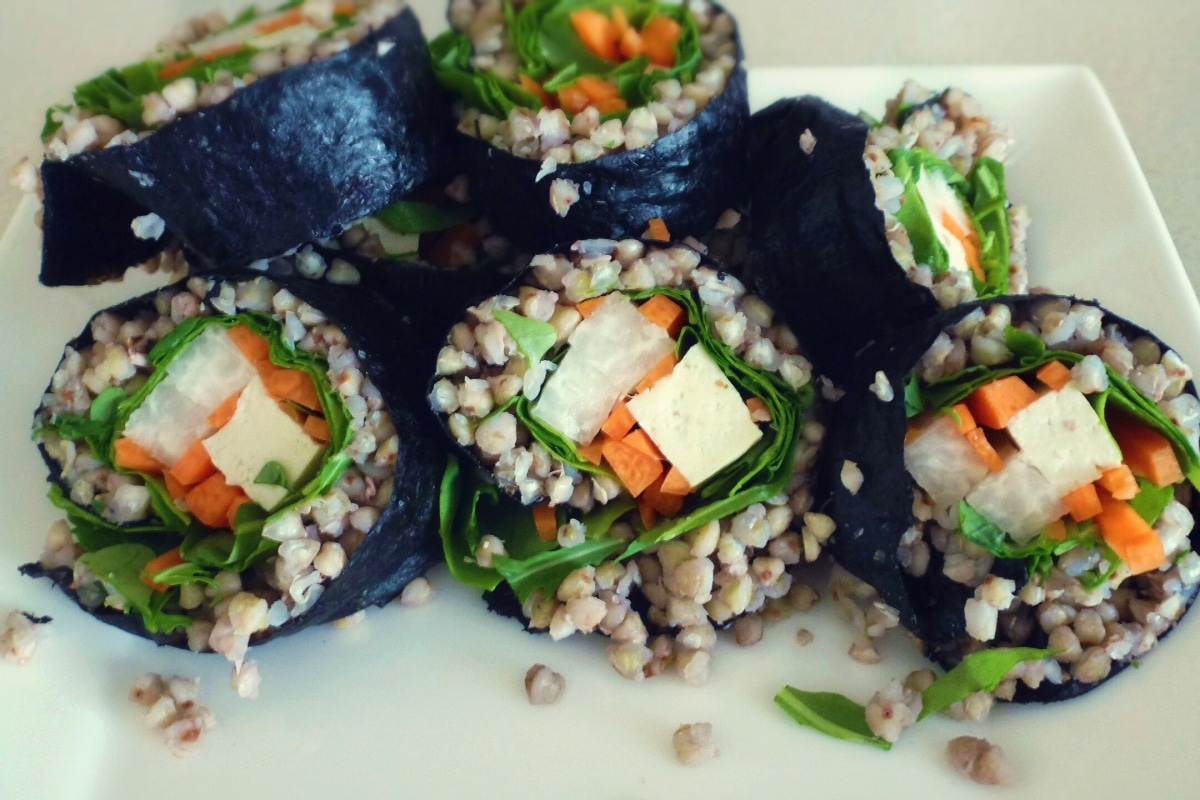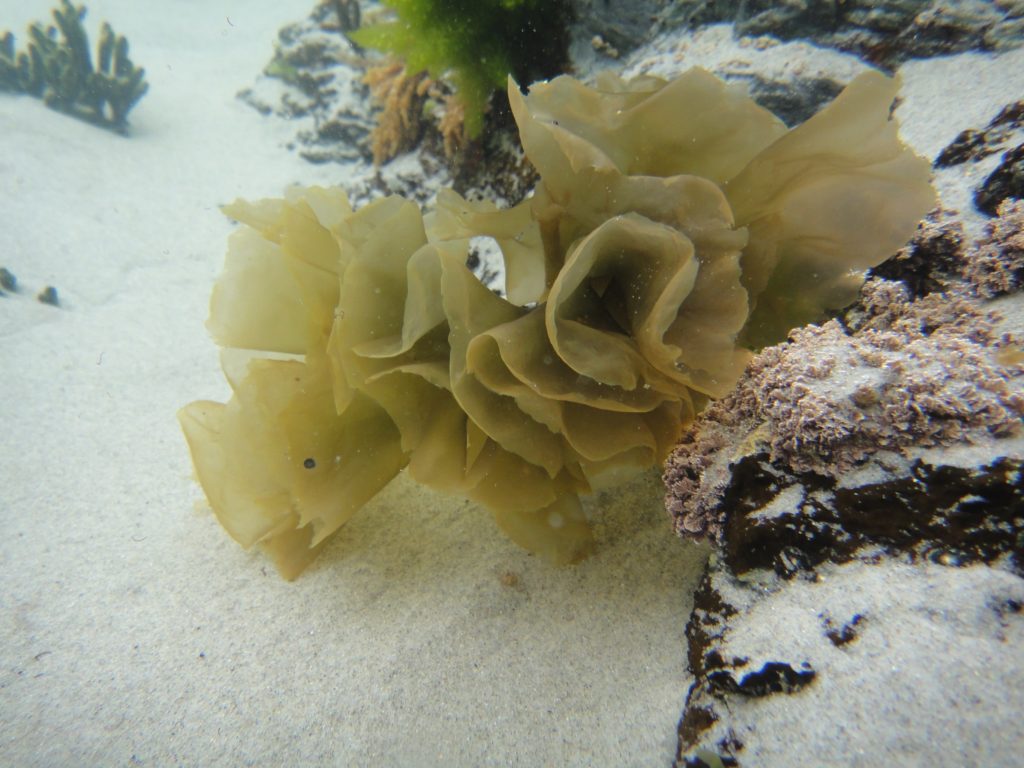This article shows all the benefits of the Nori Seaweed, a marine species whose popularity has grown around the world, especially in Japan, where it represents a millionaire industry
Table Of Content
- 1 What Are Nori Seaweed: ☘️
- 2 Nori Seaweed Production ☘️
- 3 Taxonomy and characteristics of Porphyra Yezoensis ☘️
- 4 Lifecycle ☘️
- 5 Species of Nori Seaweed ☘️
- 6 Distribution ☘️
- 7 Economic Importance ☘️
- 8 Nutritional Properties of Nori Seaweed: ☘️
- 9 Benefits of Nori Seaweed ☘️
- 10 How to use Nori Seaweed ☘️
- 11 Contraindications of Nori Seaweed ☘️
- 12 Nori Seaweed in Gastronomy: Recipes ☘️
- 13 Nori Production in the Ariake Sea ☘️
- 14 In Search of Perfection ☘️
- 15 The selection of the product ☘️
What Are Nori Seaweed: ☘️
The word Nori is used in the Japanese language, to refer to edible varieties of the red seaweed species Porphyra. The Porphyra Yezoensis and the Porphyra Tenera are the main species in this group. Although other varieties of seaweed are included such as some cyanobacteria.
The term Nori is also related, to food products made from these marine plants. They are prepared by chopping the seaweed in traces and dehydrating them with a process similar to that used on paper.
Thus , the product resulting from the nori seaweeds , is regularly used to roll both, the sushi and the onigiri. The nori is also consumed in the form of pasta, seasoned with a soy sauce called Noritsukudani.
Nori Seaweed are also used in dry and powder form, which is called aonori. This presentation performs the role of spice, in common dishes such as okonomiyaki or yakisoba.
Nori Seaweed Production ☘️
In Japan, more than 600 km2 of coastline are destined to produce 350 Thousand Tons of Nori Seaweed, which in 2002, reported an approximate income of One Billion Dollars.
It is also a known product in China, although its production in this Asian giant represents one third of the total volume produced in Japan.
We must know that both, the production and processing of Nori Seaweed, require an advanced form of agriculture. Fortunately, the biology of Porphyra despite it´s complexity, is well understood nowadays. This fact has facilitated a knowledge, that is applied to control its exploitation since the mid-twentieth century XX..
By that time the production of this alga was in decline, however the studies of Kathleen Mary Drew-Baker drastically changed this situation.
The cultivation of nori seaweeds is developed in the sea, where Porphyra plants grow, while farmers work from barges.
The plants grow quickly, taking  only 45 days from the «sowing» until the initial harvest. Then, multiple harvests can be practiced to a single sowing, which can be carried out normally every 10 days.
only 45 days from the «sowing» until the initial harvest. Then, multiple harvests can be practiced to a single sowing, which can be carried out normally every 10 days.
On the other hand, the collection of nori seaweed is practiced with mechanical harvesters configured for this purpose. The processing of the raw material is done, mostly by highly automated machines, that copy with great precision the traditional days of manual processing.
The final product of this procedure is a dry black sheet as thin as paper, of about 18 cm x 20 cm in area and about 3 grams in weight.
Taxonomy and characteristics of Porphyra Yezoensis ☘️
The Porphyra is a genera of red seaweed, composed of about 70 species. They inhabit in the intertidal zones, generally between the upper intertidal and the wave breaking area.
Its talus is a sort of foliated leaf, composed by one or two cells, with a size that ranges from few centimeters until three meters, depending on the species.
The leaves of the nori seaweeds are born individually, from a small discoidal fixer. Their basal cells have rhizoids, while the morphology of the leaves will vary from orbicular to linear, presenting smooth, jagged or rough margins.
Nori seaweed are known mainly, for being used in the elaboration of the famous Sushi. But we must mention, that this type of seaweed comes from crops. Once harvested fresh, they are dried in the sun or in ovens, exposed in low quantities on bamboo mats. Hence, their characteristic appearance of one smooth side and another rough.
Once dry, the nori seaweed product is marketed in packs of 10 sheets and its color can vary from reddish to brown, as well as dark green or black. In addition, texture, appearance and color may vary according to their condition, whether cooked or roasted, for example.
Lifecycle ☘️
Nori seaweed present a heteromorphic alternation of generations. The talus we observe is the haploid generation, which can reproduce asexually thanks to the formation of spores, that develop to replicate the original talus. But it can also reproduce sexually.
The male gametes, as well as the female ones are formed in the talus. In the case of female gametes, when they are still in the talus, they are fertilized by the liberated males´, gametes, which are immobile.
In this way, the carposporangio once fertilized, becomes diploid, producing spores or carpospores, which are established to drill the shells.
Then they germinate to form a filamentous state called Conchocelis Rosea at first, because it was thought that it was of another species ; but now it is known that it is the diploid state of Porphyra .
After the above process, spores are produced by meiosis, which when released and settling in an appropriate place, are transformed into the plant known as Porphyra .
Species of Nori Seaweed ☘️
The genera Porphyra has undergone a rigorous revision recently; through a study of molecular analysis, that has determined the transference of several of its species to new or existing genres. This is the reason why we have now Porphyra Tenera, Porphyra Yezoensis and Porphyra Haitanensis; which were grouped in Porphyra until recent times.
Distribution ☘️
This is a sort of worlwide algae, since it is distributed throughout all continents including polar, tropical and temperate waters.
Economic Importance ☘️
Although seaweed don´t belong to our traditional culinary culture, their consumption has spread throughout the world, gaining a huge popularity.
The very important nutritional properties, that both marine and freshwater seaweed possess is the main reason of this fact. These benefits have made of them, very valuable items in the global economy, especially in Asian countries.
In the case of Japan, more than 600 km2 of coastal coastline are employed to produce 350 Thousand Tons of Nori, representing an approximated income of One Billion Dollars.
Nutritional Properties of Nori Seaweed: ☘️
As we have already mentioned, the nori is generally known by being used in the elaboration of the famous Sushi, and it also has multiple properties that we will describe following.
Mineral Wealth
Like most marine algae, the nori stands out for its high remineralizing action, since it contains abundant iodine, potassium, iron, calcium and phosphorus, among other minerals.
Vitamins ☘️
The nori alga also stands out, for its high content of pro-vitamin A, vitamins of group B, such as B1, B2 and B3 and vitamin C.
Proteins ☘️
Likewise, the nori seaweed has a high content of proteins, but it should be taken into account, that the recommended intake of seaweed is low, because as most marine species they also contain iodine. Thus, we must consider a balanced diet, in order to find different sources of proteins.
Fat ☘️
Another positive aspect of the nori alga, lies in it’s low content of fat, which in conjunction with the metabolism stimulating properties of iodine , represent a great ally for losing weight.
Carbohydrates and Fiber ☘️
As in the case of almost all vegetables, nori alga contains slow assimilation carbohydrates, which are quite beneficial. The excellent effect of its fiber, must be also highlighted.
Benefits of Nori Seaweed ☘️
There are few nutritional differences between the nori seaweed and other types of algae and all of them have big advantages for health. However, we can list the follwing specific benefits of the nori seaweed.
Weight loss: stimulate weight loss in case of obesity.
Cholesterol: help reduce fat and cholesterol.
Defenses: Stimulate the immune system in case of influenza, bronchitis and infections of any kind.
Hair loss: help prevent hair loss thanks to the vitamins they contain.
Digestion: due to their content of fiber, they help metabolize food
Vision: Very useful for vision alterations, due to their high content of Vitamin A.
Intestine: They are recommended for intestinal health, and thus repopulate the intestinal flora.
Hormonal system: They work as stimulants of the hormonal system, in the presence of hypothyroidism.
Athletes: Due to their high content of nutrients, they are ideal in athletes’ diets.
Let´s keep learning
How to use Nori Seaweed ☘️
Salads: Soak slightly for a few minutes and add them to the salad.
In soups and purees: Add to cooking and let them cook a few minutes.
Rice balls: Cut them in small squares, then toast them for a few seconds over low heat. Place them directly in the pan and without oil. Prepare the rice balls, covering each one with two squares of alga already toasted, one below and another above. Stick them well, and make the rounded shape.
In flakes: If you acquire the nori seaweed in the form of flakes, you won’t have to do anything else. Just sprinkle them on any dish or stew.
Sautéed: Added to a sautéed with other vegetables and veggies.
In vegetable pates: They can be added once cooked, to any vegetable pate, for example to the pate of mushrooms.
Contraindications of Nori Seaweed ☘️
Although under normal conditions these seaweed are quite healthy, it’s necessary to keep in mind some factors, and get specialized opinion in the following cases:
Hyperthyroidism, pregnancy, when anticoagulants are ingested, in the presence of autoimmune conditions, or before surgical intervention
The iodine contained in this species must be ingested with some precautions…. Let´s learn more about this topic
Nori Seaweed in Gastronomy: Recipes ☘️
Now that we know the properties and benefits of this wonderful plants, we can make some delicious dishes
Nori Seaweed Rolls
It is known that nori seaweed have a high amount of chlorophyll and minerals, which are beneficial for health.
To make this recipe, the only extra thing we will need is a sushi mat, the rest is very easy. We hope you enjoy it.
Ingredients:
Nori seaweed sheets
Zucchini
Cucumber
Red Morron
Zucchini
Rúcula
Avocado
Spreadable Goat Cheese
Strawberries and / or mango (optional)
Caju Chestnuts (optional)
Alfalfa Sprouts
* All vegetables chopped Julienne.
Preparation:
In a nori sheet , spread a spoon full of goat cheese to spread, in addition to small pieces of avocado, rocket leaves and place on these the chopped vegetables in julienne.
Then add the strawberries and / or mango, roll them and that’s all .You can add soy sauce and just enjoy ..
Now, it is time to learn how to prepare this Delicious Dish Called Sushi:
Try more récipes…..
Pumpkin Cream with nori seaweed
Its preparation is very easy and it is just delicious
Fresh cheese
Olive oil
Onion
Potato
Liquid cream
Salt
Water; and the main ingredients, such as the nori and pumpkin flakes.
You can also use fresh cheese with pumpkin seeds for decorating this dish. If you prefer to make it in foil, a good advice is to toast it in the oven for about 3 or 4 minutes at medium intensity.
Nori Production in the Ariake Sea ☘️
The Ariake sea is located between the four prefectures of the southernmost island of Japan, Kyushu: Kumamoto, Saga, Nagasaki and Fukuoka.
This sea represents the largest bay in Kyushu, where more than 100 large and small rivers converge, such as the Chikugo river.
The difference between the ebb and flow of the tide of this sea, can reach up to 6 meters, while the tidal planes that this generates provides an unbeatable ecosystem for many life forms.
In this way, the environment of the Ariake Sea, favors a wide range of maritime products to be harvested, which are marketed throughout Japan. But particularly it gives the exquisite taste to the nori grown there, known as Ariake Nori .
Now we will try to unveil, the secret of the delicious taste of Ariake Nori, the main nori brand in Japan.
Natural Conditions ☘️
The gathering of nori in the Ariake Sea, is carried out using an unpublished system of aquaculture, known as the «pole system». A high number of poles are planted in the sea, with the nets hanging between them.
Intrinsic to this method, is the difference between the ebb and flow of the tide, which at its maximum point of six meters, is one of the largest on the planet.
At high tide, the nori is submerged in the sea water, which allows it to acquire nutrients from it.
While at low tide, the seaweed rises above sea level and receives the sun’s rays, making it more delicious. Thus, this cycle uses the power of nature to create the exquisite nori.
They also have the fresh and quite beneficial water, from the numerous rivers that flow into the Ariake Sea. This additional fact, helps reduce the salinity of the water, giving the Ariake Nori its distinctive softness.
Blessed in this way by nature, the Ariake Sea is indisputably the ideal environment for Nori seaweed farming.
This type of aquaculture depends on environmental conditions, requiring constant maintenance and great care.
The poles or posts must be adjusted both at night and day, according to a variety of factors, for example the difference of flow and reflux, temperature and weather conditions.
Enviromental Preservation ☘️
Nowadays, the most important subject for nori aquaculture, is the conservation of the environment. Thus, the companies dedicated to this business, lead their efforts in that guideline.
Except for the period of aquaculture, these companies work to cultivate the seabed and clean the coast.
 As recently, few typhoons have reached the Ariake Sea, cultivation work has become necessary to provide oxygen to the water.
As recently, few typhoons have reached the Ariake Sea, cultivation work has become necessary to provide oxygen to the water.
The cleaning of the coast is also essential, to ensure that nothing contaminates the nori, said one of the executives of the largest processor in the region.
«Environmental conservation efforts like these are of great value, not only for the sake of our nori, but also for the entire ecosystem of the Ariake Sea,» he added.
There are others factors that affect this agriculture, such as the increase in water temperature as a result of environmental changes.
It is known that year after year, the variant environmental conditions must be constantly monitored , to determine the right time for sowing and harvesting the nori.
The hard work of farmers ☘️
To obtain Ariake Nori, the nori spores are planted in oyster shells that are grown on land. Then, in October, having changed the summer season to autumn and the water temperature drops to 23 ° C or less, the spores start to germinate from the shells.
At this precise moment the nets are placed into the sea with the united nori spores, so that they can take root. Later, during the autumn and winter, that is, from October to March, the cultivation and harvest phases are carried out.
The first harvest of nori, known as ichiban tsumi, is of a special texture, very soft and exquisite flavor, so it has a high market value.
During the harvest season, the farmers take the boats at night, to collect the nori. Then during the day the product is dried, for which it is grouped and then packed.
 But at the same time, the nori networks are also laid, adjusting the poles.
But at the same time, the nori networks are also laid, adjusting the poles.
Later, during the autumn and winter seasons, the work becomes so demanding that workers only rest three or four hours per day. The nori is harvested during the night.
In this way, harvesting the cells when they are asleep, instead of during the day, when they are absorbing sunlight, gives nori better taste, and the final texture is also ideal.
But the workers must overcome, much more than the cold of the winter nights in the sea of Ariake. They say, that going out into the black field of the sea, is a terrifying sensation that they can never get used to.
They describe that they go carefully in the middle of the darkness, towards the aquaculture area, paying special attention to the waves as they move. Once in place, they must quickly and skillfully harvest the nori and then build the nets.
So, the harvest of this product in the sea of Ariake can be an exhausting job with little rest. However for many farmer the harvest season means a really stimulating moment.
Processing Nori Seaweed ☘️

Once harvested, the nori seaweed are collected in a processing plant, where they are dried in leaves and marketed.
At this point, the nori is classified into different types according to its shape and complexion, to then take it to the auction. This happens in early January of every years.
For this public marketing, Nori’s experts from all over Japan, including merchants, wholesalers and manufacturers, meet in the auction centers of the Prefecture of Saga. Even, there are auctions in other regions bordering the Ariake Sea, to dispute the «first selection» of high quality harvested during that winter
In Search of Perfection ☘️
It is world-famous the tenacious struggle of the Japanese for perfection; a passion that also extends to this area.
In this world of the nori, there is an outstanding company that has been in business for more than 160 years; the Yamamoto-Noriten. This company is located in Nihonbashi, Tokyo, but it has also started activities with a processing plant in Saga’s Prefecture.
They say that they have done it, driven by their desire to create a more exquisite nori, so they will be able to fulfill the love for perfection that characterizes Nipponese
This company is often recognized by its brand «Maruume», with a characteristic red circle on the packaging. It highlights the fact that there is great emphasis on the aroma of nori, as in their other product, the «ume». In fact the flowering season of ume which occurs during mid-winter, coincides with the harvest of the best nori.
Yuji Amakasu, manager of the department of products of Yamamoto-Noriten, affirmed that the direct contact with farmers, was the main reason of moving the plant
«Now that we are in close contact with farmers, the amount of information we have access to, has increased exponentially.
We are able to put our hands in the information of nori, that we could never in Tokyo, «he explained.
The close union with farmers, has allowed Yamamoto-Noriten to acquire a superior quality of nori like never before.
Another of the benefits, of having moved the factory to Saga, is that the employees are quite honest and reliable. This is a common characteristic of people in this location
«As we expected, these workers have proven to be fundamental in the company’s search for even better products,» he added.
But in addition to traditional nori classes, Yamamoto-Noriten has also set its own standards for qualifying nori. In this way the product they buy, is evaluated by experts with a great knowledge background.
For this reason, they appreciate both the shape and the build of the seaweed, as well as the taste. Then its use is determined in different products, such as yaki-nori, which is nori ali baked, or tsukudani.
The selection of the product ☘️
Hiroaki Fujita, assistant manager of the company’s classification office, explained the details of the classification process.
For example, based on normal standards, he explains that if nori has holes, it is immediately cataloged as of low quality.
However, «here in Yamamoto-Noriten, we do not make judgments based only on whether or not nori has holes in it. Here we classify the nori depending on its taste, and then we determine if it will adapt to our different products, «he said.
In its search for perfection , Yamamoto-Noriten moved from Nihonbashi, Tokyo, to the Ariake Sea, in the Prefecture of Saga. Its desire and determination, to satisfy all its customer, induced this decision…
Finally, as usual, we leave this video, so you can learn more about this Plant and its Farming…














This is a very interesting and well written article, thank you. The best I have read yet on Nori seaweed.
Thanls for your wonderful comment